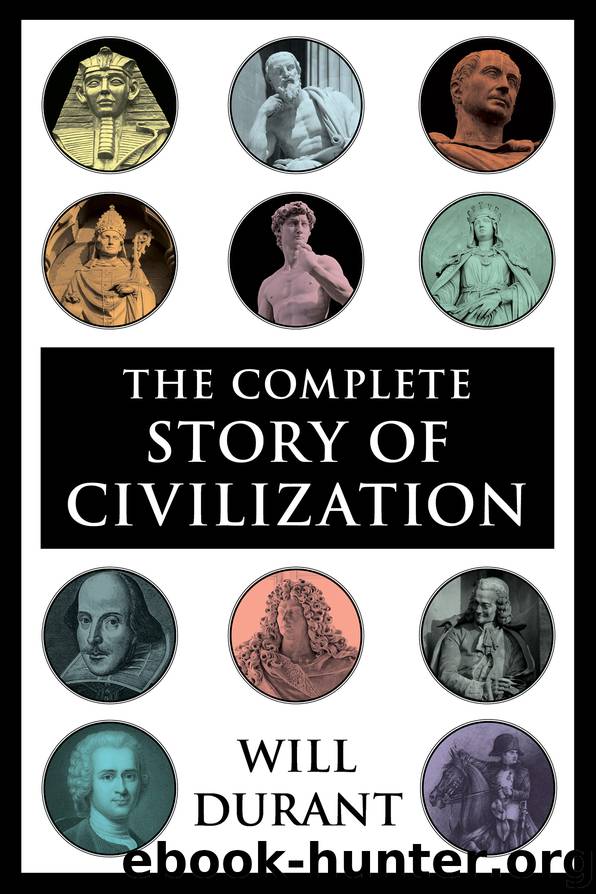Volume IV: The Age of Faith by Will Durant

Author:Will Durant
Language: eng
Format: epub
* * *
I From the Spanish cruzada—“marked with the cross.”
CHAPTER XXIV
The Economic Revolution
1066–1300
I. THE REVIVAL OF COMMERCE
EVERY cultural flowering finds root and nourishment in an expansion of commerce and industry. Moslem seizure of eastern and southern Mediterranean ports and trade, Moslem, Viking, and Magyar raids, political disorder under the successors of Charlemagne, had driven European economic and mental life to nadir in the ninth and tenth centuries. The feudal protection and reorganization of agriculture, the taming of Norse pirates into Norman peasants and merchants, the repulse and conversion of the Huns, the recapture of the Mediterranean by Italian trade, the reopening of the Levant by the Crusades, and the awakening contact of the West with the more advanced civilizations of Islam and Byzantium, provided in the twelfth century the opportunity and stimulus for the recovery of Europe, and supplied the material means for the cultural blossoming of the twelfth century and the medieval meridian of the thirteenth. For society, as well as for an individual, primum est edere, deinde philosophari—eating must come before philosophy, wealth before art.
The first step in the economic revival was the removal of restraints on internal trade. Shortsighted governments had levied a hundred charges upon the transport and sale of goods—for entering ports, crossing bridges, using roads or rivers or canals, offering goods for purchase at markets or fairs. Feudal barons felt justified in exacting tolls on wares passing through their domains, as states do now; and some of them gave real protection and service to merchants by armed escorts and convenient hospitality.I But the result of state and feudal interference was sixty-two toll stations on the Rhine, seventy-four on the Loire, thirty-five on the Elbe, seventy-seven on the Danube …; a merchant paid sixty per cent of his cargo to carry it along the Rhine.1 Feudal wars, undisciplined soldiery, robber barons, and pirates on rivers and seas, made roads and waterways a martial risk to merchants and travelers. The Truce and Peace of God helped land commerce by proclaiming relatively safe periods for travel; and the growing power of the kings diminished robbery, established uniform measures and weights, limited and regulated tolls, and removed tolls altogether from certain roads and markets in the time of the great fairs.
Fairs were the life of medieval trade. Pedlars, of course, carried small wares from door to door, artisans sold their products in their shops, market days gathered sellers and buyers in the towns; barons sheltered markets near their castles, churches allowed them in their yards, kings housed them in halles or stores in the capitals. But wholesale and international trade centered in the regional fairs periodically held at London and Stourbridge in England, at Paris, Lyons, Reims, and the Champagne in France, at Lille, Ypres, Douai, and Bruges in Flanders, at Cologne, Frankfort, Leipzig, and Lübeck in Germany, at Geneva in Switzerland, at Novgorod in Russia…. The most famous and popular of these fairs took place in the county of Champagne at Lagny in January, at Bar-sur-Aube in Lent, at Provins in May and September, at Troyes in September and November.
Download
This site does not store any files on its server. We only index and link to content provided by other sites. Please contact the content providers to delete copyright contents if any and email us, we'll remove relevant links or contents immediately.
| Africa | Americas |
| Arctic & Antarctica | Asia |
| Australia & Oceania | Europe |
| Middle East | Russia |
| United States | World |
| Ancient Civilizations | Military |
| Historical Study & Educational Resources |
Guns, Germs and Steel by Diamond Jared(2244)
Collapse: How Societies Choose to Fail or Succeed by Jared Diamond(1458)
The Emperor of All Maladies by Siddhartha Mukherjee(1378)
Transcendence by Gaia Vince(1099)
148424513X by Unknown(1000)
Seven Skeletons by Lydia Pyne(995)
Sapiens - A brief history of humankind (Marathi) by Yuval Noah Harari(931)
The Rational Optimist: How Prosperity Evolves by Matt Ridley(928)
Civilization One by Christopher Knight(920)
Guns, Germs, and Steel: The Fates of Human Societies by Jared M. Diamond(895)
THE MASTER AND HIS EMISSARY by Iain McGilchrist(894)
Marco Polo by Laurence Bergreen(863)
Underworld The Mysterious Origins of Civilization by Graham Hancock(861)
At Home by Bill Bryson(850)
Atrocitology by Matthew White(849)
How the Irish Saved Civilization by Thomas Cahill(844)
The World Until Yesterday: What Can We Learn From Traditional Societies? by Jared Diamond(828)
Ancient Iraq by Georges Roux(816)
Guns, Germs and Steel: The Fates of Human Societies by Jared Diamond(815)
